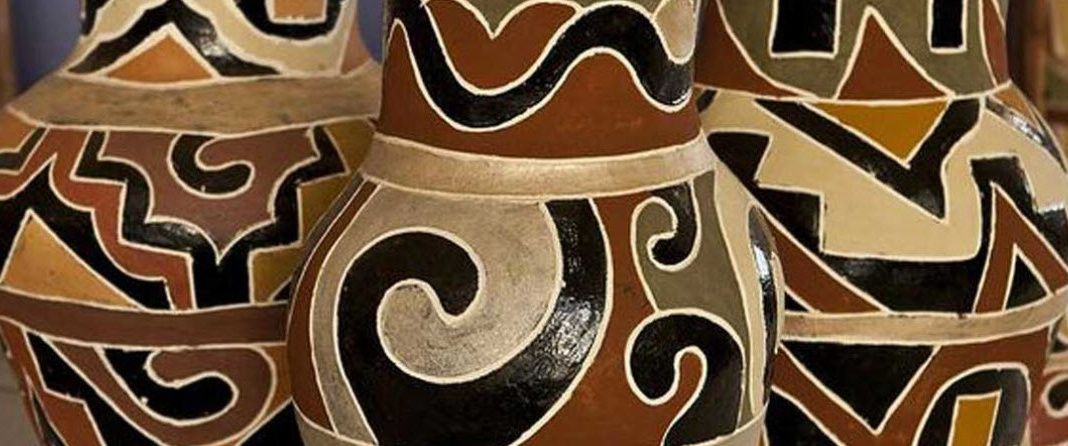- The Kadiwéu Indigenous Land is located in western Mato Grosso do Sul state, Brazil, near the Paraguay border. The protected reserve covers 539,000 hectares (1.33 million acres), spanning both the Cerrado (71%) and Pantanal (29%) biomes.
- The 1,500 Kadiwéu living in the reserve today are descended from larger Indigenous groups decimated by Portuguese and Spanish colonizers. The Kadiwéu were donated their territory by Emperor Dom Pedro II for their role in the 1864-70 War of the Triple Alliance; theirs was the first Indigenous reserve ever established in Brazil.
- The remnant Kadiwéu long seemed headed for extinction, but their culture survived and adapted. Their arts, especially pottery and body painting, were studied by international anthropologists, including Claude Lévi-Strauss. Today, the Kadiwéu are incorporating their designs into international high fashion.
- But the Kadiwéu still face challenges. Their reserve continues to be invaded by illegal loggers and land grabbers. In 2019-20, more than 40% of their reserve burned in the Pantanal biome wildfires — brought on by record drought due to climate change and irresponsible land management by ranchers. COVID-19 also looms.
- This article was first published by Mongabay on 19 March 2021. You can read the original here.
Search for “Kadiwéu” on Pinterest, the popular website where people can find inspiration for their handicraft interests and hobbies, and a great number of intricate and original artistic designs on bodies, paper and fabric will appear. That’s a very modern indication of just how successful the 1,500-strong Kadiwéu Indigenous group, who inhabit a remote area of Brazil’s Mato Grosso do Sul state, has become in making its centuries-old art relevant and accessible to a national and international public.
That art, practiced in an Indigenous reserve where the Cerrado savanna and Pantanal wetland biomes meet, is also a key survival strategy. And one of the people central to that cultural stratagem is 33-year-old Kadiwéu artist Benilda Vergílio, whose striking dresses, based on Kadiwéu designs, are prominent on fashion runways in Brazil and, increasingly, abroad.
Vergílio told Mongabay how she came up with the idea of applying her people’s traditional artistic motifs to fashion. “I was brought up in the village of Alves de Barros, within the Indigenous reserve. My grandmother, a matriarch, was called Rufina Belizário. She cultivated food, picked cotton, made bags, wove hammocks and tapestries, embroidered and made fans from palm leaves. She took everything she could from nature and transformed it.”
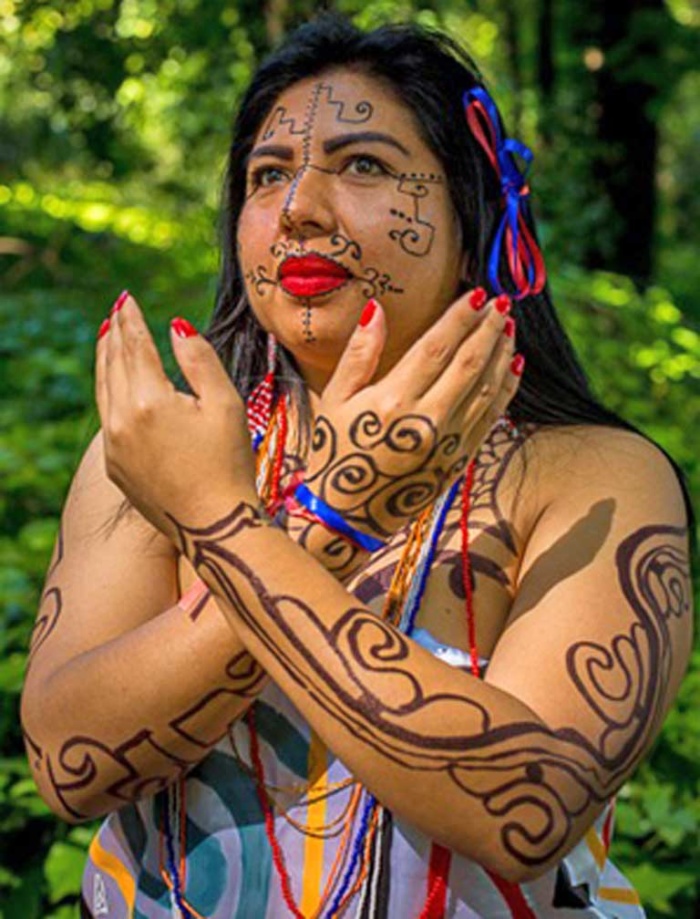
Her grandmother, Vergílio says, was determined to keep Kadiwéu culture alive. “Each year she held the festival of the menina moça, [a traditional celebration marking the rite of passage of a girl into womanhood], and organized cantorias [singing festivals]. I had a very strong link with her.”
While still a child, Vergílio had the idea of using Kadiwéu designs on clothing. “Another child, visiting our village, left behind copies of Capricho.” Capricho is a well-known Brazilian teen magazine, chock-full of fashion trends, celebrity gossip, horoscopes and love stories. “I thought then what fun it would be to use some of the designs we were creating at home for our pots and baskets on these fashionable dresses.”
Vergílio left her village, aged 10, after her grandmother died, and later attended art college. But still she clung to her idea of using Indigenous art in fashion, and designing clothes. Eventually she took part in fashion reviews, first in the nearest state capital, Campo Grande, and then in São Paulo, one of the world’s top 10 fashion centers.
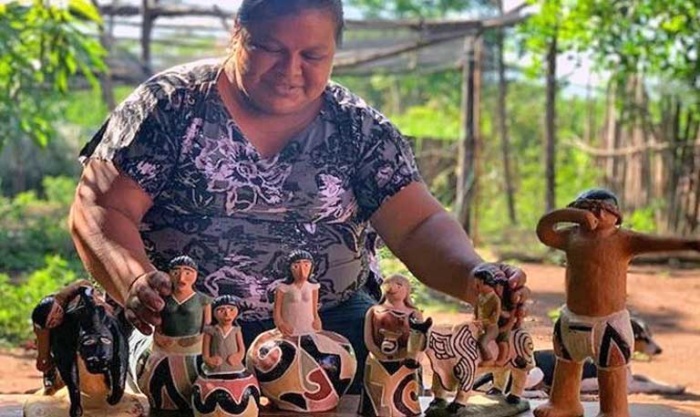
Building creative partnerships
Vergílio still lives in her home region and today is sub-secretary of public policy for Indigenous populations in the Mato Grosso do Sul government. Passionate about her vocation, she travels from village to village, talking to Kadiwéu women and helping them value the distinctive pots, bags and tapestries they make.
“I get them to see that their work is lovely and that they shouldn’t be selling it cheaply to middlemen. I adore helping unknown women get recognized for the gorgeous work they do,” she says.
Her job could soon get easier: the Mato Grosso do Sul government, the Federal University of Mato Grosso do Sul (UFMS), and Canada’s Manitoba University are teaming up with the Association of Kadiwéu Women Artists to find new ways for the women to sell their extraordinary work. Plans include the opening of a cultural center in the village of Alves de Barros, where Vergílio was raised, plus the creation of an online shop.
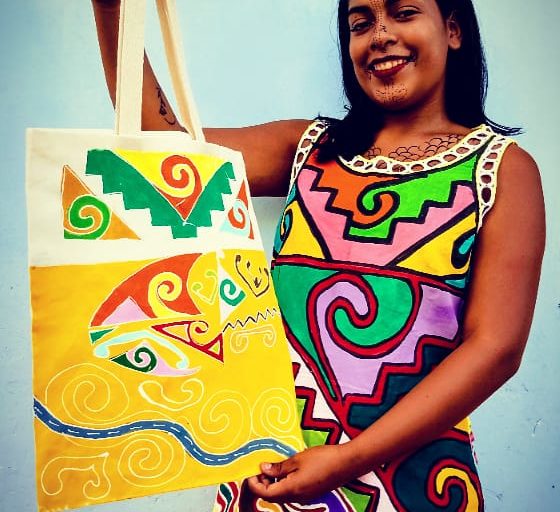
“It brings us a great deal of satisfaction to see the happiness of the community with these plans,” says Antônio Hilário Urquiza, a UFMS lecturer in anthropology and project coordinator. The initiative is “empowering these women and will help them to sell their products directly to their customers.”
The production of highly unique Kadiwéu pottery and other handicrafts not only contributes to livelihoods — it plays an important role in family life, the passing down of culture, and also connects Indigenous artisans with nature.
Keyciane Lima Pedrosa, who works for Funai, Brazil’s Indigenous affairs agency, explains: “The way they select the mud, mold the pots, mark out the designs with strands of caraguatá [a kind of native bromelia], cover the pots with resin from pau-santo palm trees [endemic in the Chaco region] and then search out colored clays with which to paint them — all these stages involve various actors in the family tree and have an important role in the transmission from generation to generation of traditional knowledge.”
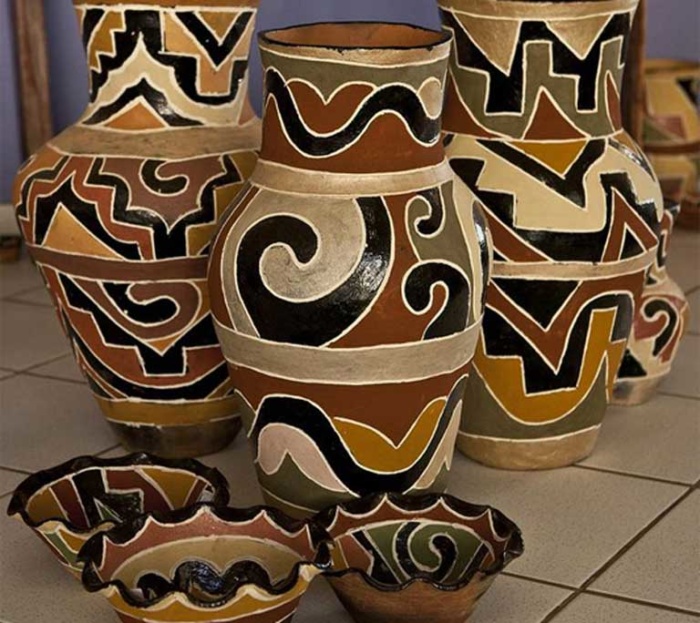
A strategy of resilience and adaptation
This meticulous creative process has long fascinated academics. One of the first to study Kadiwéu pot making was the Italian ethnologist Guido Boggiani, who, at the end of the 19th century, made a systematic register of Kadiwéu pottery, sculptures and body paintings. In the 1930s, the renowned French anthropologist Claude Lévi-Strauss visited their territory and reproduced their patterns in photographic and diagrammatic form in influential anthropological publications.
Many of these early foreign visitors feared they were witnessing an Indigenous culture on the way to extinction. But this proved not to be the case. Heather Roller, director of the Native American Studies Program at Colgate University in the U.S., says many of the clues to the Kadiwéu’s capacity to adapt and survive are evident in the academic studies themselves. In an article published in 2018, she writes: “The early ethnographies contain evidence of deeply rooted but flexible practices of alliance, appropriation, and resistance. Like many Indigenous groups in the interior spaces of Brazil, the Kadiwéu used these strategies to defend their autonomy and territory during a century of challenges.”
The foreign visitors’ work was helpful in this process. Luciana Martins, professor of Latin American visual cultures in the School of Arts at Birkbeck, part of the University of London, says Lévi-Strauss’s research helped transmit Kadiwéu culture globally, leading, for instance, to the decision in 1997 to use their designs in residential blocks in a housing project in Berlin, Germany.
This far-flung Indigenous cultural influence continues today. Martins explains: “It was very moving to see the Kadiwéu art at the exhibition, ‘Géométries Sud: du Mexique à la Terre de Feu’ at the Fondation Cartier pour L’art Contemporain in Paris in 2018, and to realize that the Kadiwéu women’s authorship was being properly acknowledged and that they were properly remunerated for the right to show their work.”
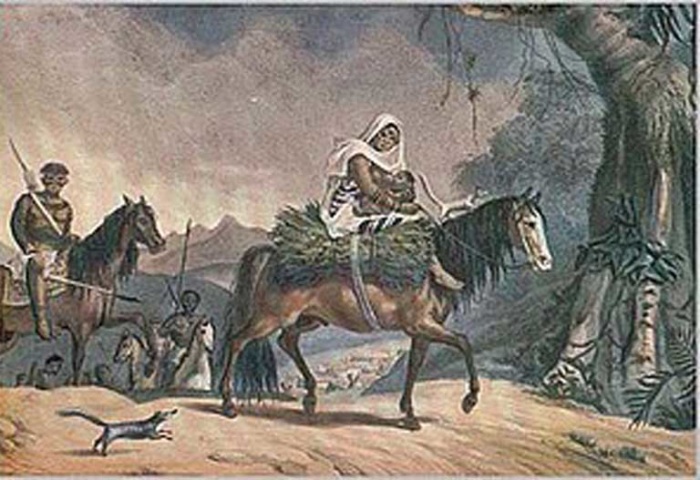
A heritage of struggle and survival
The Kadiwéu have a remarkable history. They are the descendants of the Mybayá-Guaikuru, one of the many Guaikuru groups that inhabited the Gran Chaco region of South America at the time of the arrival of Spanish and Portuguese colonizers in the 16th century.
The Guaikuru Indigenous groups were driven east across the Paraguai River by the colonials, and suffered fearful losses. By the second half of the 19th century, only the group from which the Kadiwéu are descended survived. According to Giovani José da Silva, a history lecturer at the Federal University of Amapá, who lived among the Kadiwéu from 1997 to 2004, they are the only remaining group in Brazil to speak a Guaikuru language.
This capacity to adapt and survive, referred to by Heather Roller, has long been evident. An early known example is the readiness with which they incorporated horses into their way of life. Horses were unknown in South America until colonizers introduced them, but the Kadiwéu soon started breeding them, probably as early as the 16th century.
In his book, A Reserva Indígena Kadiwéu (1899-1984): Memória, Identidade e História, Da Silva says the Kadiwéu became extremely skillful horsemen, gaining the nickname of “índios cavaleiros” (horsemen Indians). The Kadiwéu, who probably numbered about 7,000-8,000 in the18th century, are believed to have owned about the same number of horses.
This rich history of adaptation and creative productivity shaped the Kadiwéu identity. Vergílio remembers an elder in her village telling her: “The day a family doesn’t produce pots and paint its bodies, the day it doesn’t rear two horses for its own use, and the day it doesn’t speak the Kadiwéu language, that day will mark the end of the Kadiwéu.”
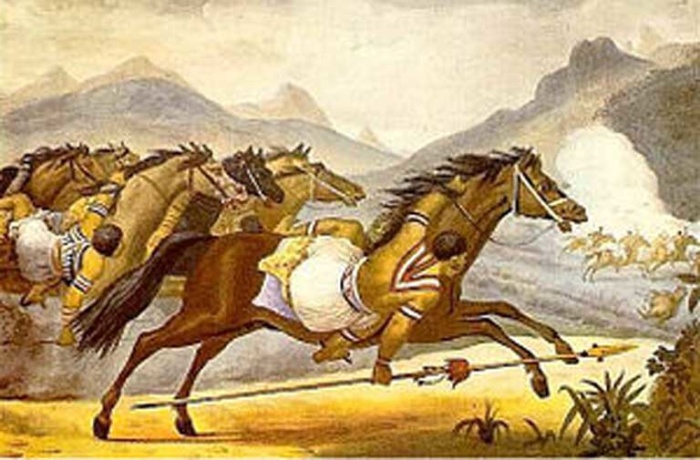
Territorial rights born out of war
So renowned were the Kadiwéu that the Emperor Dom Pedro II recruited them to fight on Brazil’s side in the War of the Triple Alliance, in which Brazil, Argentina and Uruguay fought Paraguay. Lasting from 1864 to 1870, it is generally regarded as the bloodiest conflict between nations in Latin America’s history, though the exact death toll isn’t known. The emperor rewarded the Kadiwéu for their role by agreeing to create a reserve for them — the first in Brazil.
But it was only in 1984, after they had resisted repeated attempts by outsiders to drive them off their land, that the Kadiwéu’s rights over their territory were formally recognized by the modern Brazilian government. Their reserve, known as the Kadiwéu Indigenous Land, is located in western Mato Grosso do Sul, not far from the border with Paraguay. It covers 539,000 hectares (1.33 million acres), spanning both the Cerrado (71%) and Pantanal (29%) biomes.
Even after formal recognition, the Kadiwéu continued to endure pressures from outsiders. Initially, 23 ranchers, whose land was located within the newly established reserve, refused to move out. After a long legal battle, the Federal Justice of Mato Grosso found in favor of the ranchers in 2012, authorizing them to reoccupy their land. Funai, the Indigenous affairs agency, appealed, and in August 2018, a superior court ruled in the Kadiwéu’s favor, concluding that “there is no way in which a decision to give possession of land to non-Indians within legally demarcated Indigenous land can be ratified.”
Since then, conflicts have rumbled on. Vergílio says illegal loggers and land grabbers are always lurking within the reserve. “We patrol the land to keep them out, but they find ways in, stealing wood and even animals,” she explains.
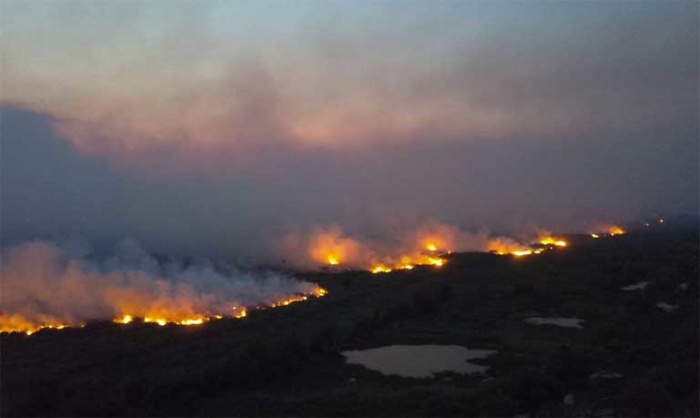
Two new invaders: Fire and the pandemic
In 2019 and 2020, the most serious threat to the Kadiwéu became the runaway wildfires that broke out in the Pantanal and which burned a significant portion of their territory. According to the Laboratory of Environmental Satellite Applications at the Federal University of Rio de Janeiro, 247,300 hectares (611,000 acres) of Kadiwéu territory, about 46% of the total, were burnt by the end of November 2020. Until recently, the Pantanal had been too wet to burn, but climate change has brought severe drought, while many fires in the biome have allegedly been lit by irresponsible cattle ranchers seeking to expand pastures; JBS and other Brazil meatpackers were also recently linked to the devastating Pantanal fires, according to NGO Greenpeace.
“It’s painful to see your relatives waking up in the night because the smoke makes it hard to breathe,” Vergílio says. “So far, the worst fire was the one that occurred at the end of last year. The well in our house dried up as a result. Our house is a long way from the village, and no water makes life very difficult.”

The situation would have been worse had it not been for the creation in December 2019 of the Kadiwéu Association of Indigenous Firefighters (ABINK), which led to the training of 15 Indigenous firefighters by the National Center for Combatting and Preventing Forest Fires, part of IBAMA, Brazil’s environmental agency. ABINK not only fights fires; it has also reforested the area around the spring that brings water to Alves de Barros, the largest of the six villages in the Indigenous territory.
Creusa Vergílio, president of the Association of Kadiwéu Women Artists (AMAK), said the fires and the pandemic have combined to leave the Kadiwéu with less to eat and a loss in income: “With the fires, we can’t find many of the fruits we normally eat. We can’t find guavira and other types of food. The pandemic has also made it harder to sell handicrafts.”
However, despite all the historical and modern challenges faced by the Kadiwéu, they remain as committed as ever to their cultural heritage. “During the pandemic a lot of Kadiwéu are practicing some kind of art. It’s good for the soul,” Benilda Vergílio says. She is echoing a sentiment expressed by Brazilian anthropologist Darcy Ribeiro after a visit to the Kadiwéu territory in 1948. They have “a wish of beauty,” he said, in which they insist that everyday domestic utensils not only be useful, but also be made to be aesthetically pleasing.
Banner image: Close up of Kadiwéu pottery designs. Image courtesy of the Mato Grosso do Sul government.

